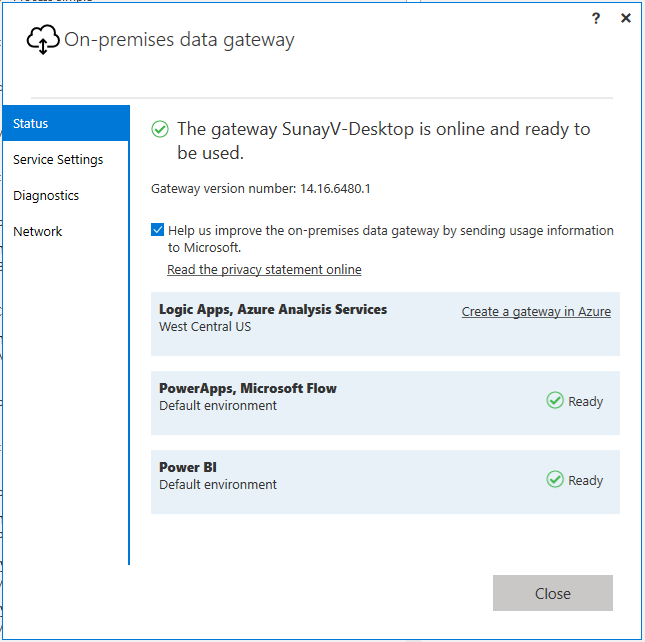Describe how Power Platform works with on-premises solutions
Microsoft Power Platform provides a robust way to integrate with on-premises solutions, enabling seamless data integration and process automation. This capability is essential for organizations that need to connect their cloud-based applications with existing on-premises systems.
How Power Platform connects with on-premises systems
Many organizations operate in hybrid environments, where some systems and data are stored locally (on-premises) while others are hosted in the cloud. Microsoft Power Platform bridges this gap using on-premises data gateways, which act as secure connectors between cloud-based tools like Power Apps, Power Automate, and Power BI, and local resources such as databases or file servers. This allows businesses to integrate their local systems with cloud-based solutions, streamlining workflows and enhancing productivity without compromising security.
The gateway is installed as a service on a computer or server within your organization’s network. Once installed, it acts as a bridge that enables cloud tools to securely access on-premises resources. For example, if your company has a database stored on a local server, the gateway allows Power BI to pull data directly from that database to create reports or Power Automate to update records automatically based on new inputs. This eliminates the need for manual data transfers and ensures seamless communication between systems.

Security is a key feature of the gateway. When you set up a connection to an on-premises resource, you provide credentials—such as a username and password—that allow access to the system. The system encrypts these credentials before storing them in the cloud, converting them into a secure code that unauthorized users cannot read. When the gateway accesses the resource, it decrypts the credentials to log in and retrieve the necessary data. This process protects sensitive business information.
Managing the gateway is straightforward. Administrators can assign coadministrators to share responsibility for managing it, ensuring there’s always someone available to handle updates or troubleshoot issues. This capability is especially important in larger organizations, where employee turnover or absences could impact operations. Having multiple administrators ensures continuity and smooth functioning of the gateway.
The on-premises data gateway is valuable for businesses that want to use their existing investments in local systems while taking advantage of modern cloud-based tools. For example, a retail company might use a local database to track inventory but rely on Power BI in the cloud to analyze sales trends across multiple locations. By installing the gateway, companies can ensure that Power BI can securely access the inventory data directly, allowing the team to generate real-time reports without manual intervention. Similarly, workflows created in Power Automate can automatically update the local database whenever new sales data is entered into a cloud-based system, ensuring consistency across platforms.
This integration saves time and improves efficiency and decision-making. Businesses can automate repetitive tasks, reduce errors, and access real-time insights, all while maintaining the security of their local systems. The gateway provides a scalable solution that grows with the organization, supporting expanding workflows and connections as business needs evolve.
In summary, the on-premises data gateway is a powerful tool for businesses operating in hybrid environments. It enables secure, efficient, and seamless integration between local systems and cloud-based tools, helping organizations maximize the value of their existing resources while embracing the benefits of modern technology. Whether it’s automating workflows, analyzing data, or building custom apps, the gateway plays a crucial role in driving business success.
Let’s look at a real-world example. Consider a retail company that tracks inventory using a local database stored on a server at its headquarters. At the same time, the company uses Power BI in the cloud to analyze sales trends across multiple locations. Without the gateway, the team would need to manually export data from the local database and upload it to Power BI. This process is time-consuming and error-prone. By installing the gateway on the server, Power BI can securely access the inventory data directly, allowing the team to generate real-time reports without manual intervention.
Similarly, the company could use Power Automate to create workflows that automatically update the local database whenever new sales data is entered into a cloud-based system, ensuring consistency across platforms.
Some of the key benefits for businesses include:
- Seamless integration: The gateway connects cloud tools to on-premises systems, enabling hybrid workflows without disrupting existing processes.
- Improved efficiency: Automating repetitive tasks and enabling real-time data access reduces manual effort and speeds up operations.
- Enhanced security: With encrypted credentials and secure communication, businesses can confidently integrate their systems without compromising sensitive data.
- Scalability: As businesses grow, the gateway supports expanding workflows and connections, making it a future-proof solution.